From sap to syrup....
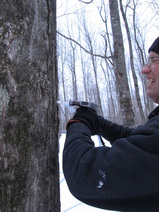
Our sugar maple trees are tapped approximately 15 days prior to the anticipated sap run. A 19/64" drill bit is used to create a hole about 1" deep. A plastic tap (spile) , that is connected to tubing, is immediately placed in this hole and tapped in gently with a hammer. Most of our trees have one tap placed unless they are very large trees (24" diameter or larger), in which they may have 2 taps.
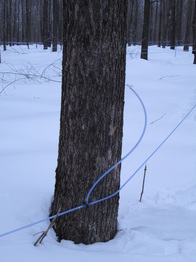
As soon as the days reach 35 - 40 degrees but the nights still freeze to approximately 25 degrees, the sap will begin to flow. The thawing days and freezing nights are necessary to maintain a good flow of sap. The sap flows downhill through the tubing, which gets progressively larger in diameter the closer it gets to the sugar shack, where it will be processed further.
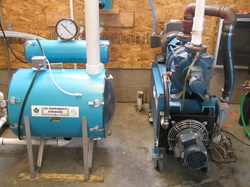
A vacuum pump is used to help draw the sap into the sugar shack. The sap is collected in large tanks until there is enough to filter and boil into syrup.
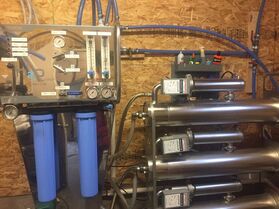
When a sufficient amount of sap is collected, it is pumped through the reverse osmosis machine, where most of the water molecules are removed. This is accomplished by forcing the sap through a membrane under pressure. Because it takes approximately 40 gallons of sugar maple sap to produce just one gallon of syrup, this process saves much time and energy in the boiling process. When the sap leaves the reverse osmosis machine, approximately 70% of the water has been removed and is now ready to be boiled down in the evaporator.
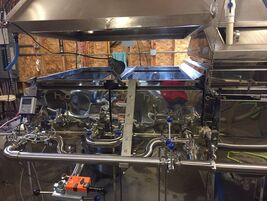
The sap now enters the evaporator which is a long stainless steel box with pans to boil the syrup in. Overhead are hoods while a firebox lies directly below the evaporator which heats the sap above. The sap is boiled down (with much care!) until it reaches 67% sugar content, which is considered syrup. This stage requires constant monitoring as a steady temperature and constant sap flow must be maintained to transform the sap into syrup.
The smell of the boiling sap in the evaporator is just incredible!
The smell of the boiling sap in the evaporator is just incredible!
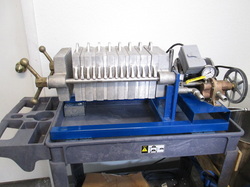
Next, the syrup goes through a filtering process to remove the "sugarsand" that can make the syrup cloudy. This "sugarsand" is actually just minerals naturally found in the sap that have become concentrated as the sap is concentrated into syrup. The filter press is a horizontal stack of metal holders with paper filters sandwiched in between. A pump forces the thick syrup through these filters to produce a clear maple syrup.
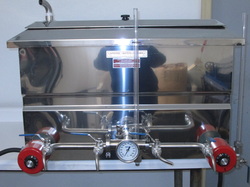
The hot clear syrup is now poured into a water-jacketed bottling unit and heated to approximately 190 degrees. While at this temperature, it is released into bottles from the bottler taps.